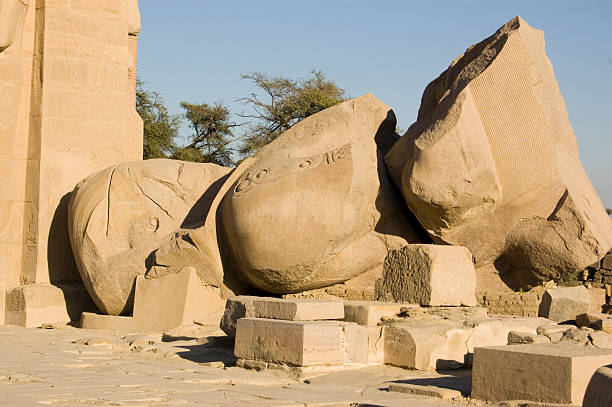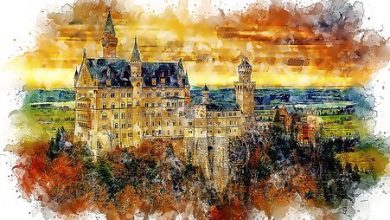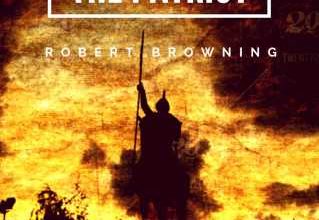
Ozymandias, published in 1818 in The Examiner of London, deals with themes of the transience of power, and the futility of ego and pride. It is a cautionary tale to remind the readers that time washes everything away, and it is better to use a powerful position for good, rather than for tyranny.
The structure of the poem is based on a Petrarchan sonnet. This type of sonnet has a specific rhyme scheme and is split into an octave and a sestet. “Ozymandias” sort of follows the ABAB rhyme scheme, and there is a clear distinction of the 8 lines of the octave, followed by the 6 lines of the sestet. The rhymes are not perfect, and sometimes the poet employs slant rhyme. In this type of rhyme, the words do not have identical sounds but are similar. However, this may also be due to the differences in accent, enunciation, and pronunciation in P.B. Shelley’s era versus the present era.
Ozymandias | Summary and Analysis
Ozymandias | Analysis, Lines 1-8
I met a traveller from an antique land,
Who said—“Two vast and trunkless legs of stone
Stand in the desert. . . . Near them, on the sand,
Half sunk a shattered visage lies, whose frown,
And wrinkled lip, and sneer of cold command,
Tell that its sculptor well those passions read
Which yet survive, stamped on these lifeless things,
The hand that mocked them, and the heart that fed;
The speaker narrates a conversation he had with a traveler from a faraway land. He walked through an area that tells stories of a bygone era and calling this place an “antique land” already shows us that the poem’s subject is set in the past. The traveler brings back memories of relics left behind that may still be of some value in the present day.
The traveler saw the remains of a large statue, with two large legs still standing tall, but the broken face lying nearby. The statue had been destroyed by sand and time and was left sunken and alone in the sand. The expression on the face betrayed cruelty and superiority, and it’s clear that this was the true personality of the person who was memorialized. The sculptor could properly read the soul of the man, and this was perfectly captured in the sculpture.
The sneer, frown, and curled lip show that the king was cruel, and this characteristic of him is what lives on after his death. This statue was meant to make sure that he is never forgotten, but neither the poet nor the traveler knew who he was. All that they gleaned from the statue was that he was cold and dominating. The legacy of the man was no longer his work or his action, but the emotion that he filled the people around him with. Power should be used for the welfare of the populace, not for the glorification of self. Ozymandias used his power to boost his ego, but all that is left is a broken statue with scattered parts.
In “The hand that mocked them, and the heart that fed;”, synecdoche is used to represent the relationship between the sculptor and the king, and by extension, the king and his subjects. The “hand” represents both the king and the sculptor. The king mocked his people and cared less about them than his own image. He did not have generous, giving hands, but instead had vengeful, selfish hands. A tyrant, he built a statue of himself to force the population to exalt his presence, whilst he should have focused his efforts on elevating the people and their standard of living. The sculptor, however, mocked the king. It is his hand that shaped the features of the statue, and Ozymandias’ domineering nature was put on show, so the statue was more of a mockery than veneration. The “heart” represents the heart of the king, symbolizing a king who fed upon the fear of his subjects, whose terrible heart supported his arrogance and ego.
Yet, all that is left of these delusions of grandeur are legs stuck in the sand and a shattered, sunken head. His belief that his empire would live long is ridiculed by the fact the remains of his statue are all that is left. The statue was made by the arrogant king who wanted his power and stature to be remembered forever, but all it proved is the temporary nature of power and influence, and how it does not last forever.
There is strong imagery used in this poem, and we are able to conjure the image of a ruined statue lying alone in the sands of a desert. Phrases like “Half sunk a shattered visage lies” evoke an image in the mind’s eye of a broken bust sinking into the desert, alone, untouched, and defeated.
Ozymandias | Analysis, Lines 9-14
And on the pedestal, these words appear:
My name is Ozymandias, King of Kings;
Look on my Works, ye Mighty, and despair!
Nothing beside remains. Round the decay
Of that colossal Wreck, boundless and bare
The lone and level sands stretch far away.”
And there, on the pedestal that holds up the legs, the mystery is solved. The man is Ozymandias, and he is a king. He is not just any king, but the best of the lot. His power and empire will distress all this who lay eyes upon it, and this is juxtaposed with the empty desert. Nobody will see him and despair about themselves, as his empire is no longer there. He is alone, destroyed, and irrelevant. He is a wreck that is decaying, and his bold words ring empty in the colossal desert that he sinks into.
The sestet is clearly defined as it is the resolution, so to speak, of the information provided in the octave. The first 8 lines are descriptive and set the scene. The final six lines resolve the mystery of who is being spoken about and expresses the irony in the poem. Thus, the need for distinct parts of the sonnet is understood, as these two parts create the whole story when combined.
The irony of this poem is that Ozymandias thought so much of himself, yet he is left surrounded by absolutely nothing. Power, pride, and tyranny have no place in the long run, and all these illusions of power will disappear as time goes on. He built up a grand image of himself, and the reality is that none of that even exists. The only reason he is remembered is because of the words on his pedestal, and not anything else. This “King of Kings” is scattered around an empty desert with nobody to see him.
Here, alliteration is used in “boundless and bare” and “lone and level”. This emphasizes the emptiness that surrounded the remains of the sculpture and reinforces the lack of grandeur that Ozymandias held so dear. The desolate expanse directly contrasts the supposed awe-inspiring and glorious empire of the king.
The poem is based on Ramesses II, who was a Pharaoh in the Nineteenth Dynasty of Egypt. He was also called Ramesses the Great and is known as the most powerful Pharaoh of Egypt. The name Ozymandias is derived from the name he used while reigning, which was romanised as Osymandyas. He was called the Great Ancestor, and in his honour, 9 succeeding pharaohs took the name Ramesses. The real inscription on Ramesses’ sculpture, inscribed by Diodorus Siculus is “King of Kings am I, Osymandias. If anyone would know how great I am and where I lie, let him surpass one of my works.” Historically, he is portrayed as a vengeful tyrant, and this is what is expressed by P.B. Shelley.
Pharaohs of that time saw themselves as akin to a god, and Ramesses was no different. He had many statues of himself built so that he would always be on the minds of his people, and they would see his likeness wherever they went. Ramesses was also known to update existing states with a stamp of his own, bearing his name, though he had no hand in building them at all. In the poem, this is represented by “stamped on these lifeless things”. He wanted to enhance his image and did it any way he could. The lifeless things he stamped were to make him look great, and now his cruelty is stamped on the history of the world through his stone face.
P.B. Shelley’s poem reminds us to use the time we have well and to make a good impact. Wealth and power are meaningless in the face of the passage of time and does nothing but leave behind an image of a tyrant. We have limited time on Earth, and we should strive to use it to improve the lives of those around us.
Ozymandias | About The Poet
P.B Shelley was born on 4 August 1792, in the United Kingdom
He was an English poet during the Romantic era and usually wrote about idealist, sceptical, religious, or materialistic themes. He had many radical political and social views, which led to critics condemning his private life while simultaneously recognising the beauty of his poetry. In his lifetime, his poetry was read only in a small circle of friends and critics, and his work had very poor sales. Soon, his poetry gained a wider readership in radical circles, but his true popularity came only after his death. Now, his mastery of imagery, lyric poetry, verse, and complex ideas is recognised all across the world.
He is well-known for his style of long-form poetry, like “Alastor”, as well as his collections of poetry. While he was alive, he also wrote several essays on political and social issues, and these lay unpublished due to fear of prosecution for libel, or defamation. However, his writing was admired by several great figures like Gandhi, Marx, and George Bernard Shaw. He also influenced generations of poets after him, like Browning, Yeats, and Hardy.
Some notable works of Shelley’s are “Ode to the West Wind”, “Adonais”, “To a Skylark”, and “The Masque of Anarchy”.
He died on 8 July 1822, in Italy.



